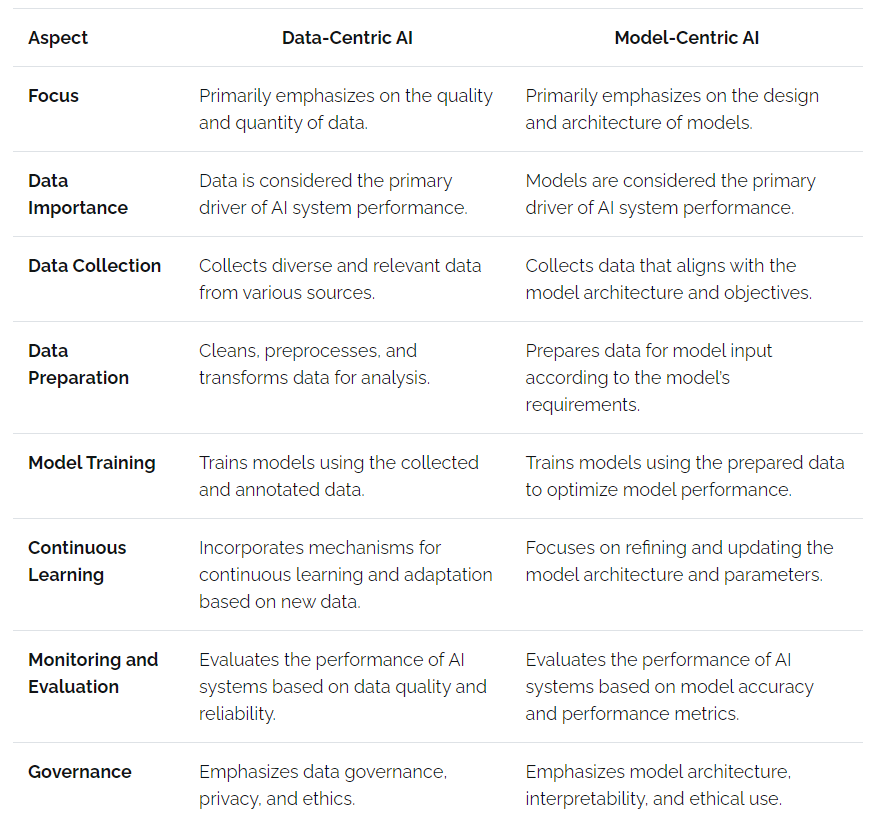Summary: Data-centric architecture in AI prioritises data quality and accessibility to enhance AI accuracy, robustness, and fairness, offering improved decision-making and adaptability.
Introduction
Data plays a crucial role in Artificial Intelligence (AI). It is the lifeblood that fuels AI algorithms and enables machines to learn and make intelligent decisions. Organisations are adopting data-centric architectures in AI to harness the power of data effectively.
But what exactly is data-centric architecture in AI? This article will explore its significance, examples, benefits, and implementation strategies. So, let’s get started!
Read More:
Advantages and Disadvantages of Artificial Intelligence.
Unveiling the battle: Artificial Intelligence vs Human Intelligence.
The Importance of Data-Centric Architecture
Data-centric architecture prioritises placing data at the core of AI systems. It focuses on collecting, storing, and processing high-quality data to fuel accurate and reliable AI models. This approach ensures that organisations harness the full potential of their data, enabling them to extract valuable insights crucial for informed decision-making.
By emphasising data quality and accessibility, data-centric architecture enhances the reliability and effectiveness of AI applications. It ensures that the data used is comprehensive and relevant, improving the accuracy of AI systems’ predictions and recommendations. Moreover, this architecture facilitates the integration of diverse data sources, allowing organisations to leverage a broader range of information for analysis.
Implementing a data-centric approach transforms how organisations derive value from their data assets. It promotes agility and innovation by enabling faster data-driven decision-making processes. Furthermore, by establishing robust data governance frameworks, organisations can ensure data security, compliance, and ethical use, fostering stakeholder trust.
How Does Data-Centric AI Work?
Now that you understand Data-centric architecture, knowing how Data-centric AI works is pivotal. By comprehending its workings, individuals and businesses can harness its power to innovate, optimise processes, and stay competitive in the evolving digital landscape. The following section highlights the critical steps to its functioning.
Data Collection
The process begins with collecting relevant and diverse data from various sources. It can include structured data (e.g., databases, spreadsheets) and unstructured data (e.g., text, images, videos).
Data Preparation
Once collected, the data must be preprocessed and analysed. It involves cleaning the data, removing noise and inconsistencies, handling missing values, and transforming it into a suitable format for AI algorithms.
Data Annotation
In many AI applications, data annotation is necessary to label or tag the data with relevant information. For example, in image recognition tasks, each image may need to be labelled with the objects it contains. Data annotation can be done manually or using automated techniques.
Training Data Selection
A critical aspect of data-centric AI is selecting the correct subset of data for training the AI models. It involves choosing representative data that covers the desired range of inputs and targets, avoiding biases, and ensuring the data is diverse and balanced.
Model Training
AI models are trained using various Machine Learning techniques after preparing trained data. These models learn from the patterns and relationships present in the data to make predictions, classify objects, or perform other desired tasks.
Continuous Learning and Iteration
Data-centric AI systems often incorporate mechanisms for continuous Learning and adaptation. As new data becomes available, the models can be retrained or fine-tuned to improve performance.
Data Governance and Ethics
Given data’s critical role, data-centric AI emphasises the need for robust data governance practices. These include ensuring data privacy, security, and compliance with ethical guidelines to avoid biases, discrimination, or data misuse.
Monitoring and Evaluation
Data-centric AI systems require continuous monitoring and evaluation to assess performance and identify potential issues. It involves analysing metrics and user feedback and validating the accuracy and reliability of the AI models.
By prioritising data quality, diversity, and accessibility, data-centric AI aims to enhance AI systems’ accuracy, reliability, and fairness, enabling them to make better-informed decisions and provide valuable insights across various domains.
Check More:
Big Data and Artificial Intelligence: How They Work Together?
Application of Artificial Intelligence in Education.
Tabular Representation of Data-Centric AI vs. Model-Centric AI
Understanding Tabular Representation in Data-Centric AI versus Model-Centric AI is crucial. It distinguishes how data structures influence AI. Knowing this aids in choosing AI approaches tailored to specific data types and analytical goals. A tabular representation comparing data-centric AI and model-centric AI is given below:
In summary, while data-centric AI prioritises the quality, diversity, and accessibility of data, model-centric AI focuses more on the design, architecture, and optimisation of AI models. Both approaches are essential and can be complementary in building robust and effective AI systems.
Also See:
How can a DevOps team take advantage of Artificial Intelligence (AI)?
5 Most Important Subsets of AI (Artificial Intelligence).
Benefits of Data-Centric AI Architecture
Data-centric AI architecture offers several benefits that contribute to the effectiveness and performance of AI systems. This knowledge empowers organisations to harness data effectively for strategic decision-making and competitive advantage. Here are some key benefits:
Improved Accuracy
By emphasising the quality and quantity of data, data-centric AI architecture nuances the accuracy of AI models. High-quality data enables better pattern recognition and understanding, leading to more precise predictions and decisions.
Enhanced Robustness
Data-centric AI systems are designed to handle diverse and representative data, making them more resilient to variations and outliers. Robust models trained on comprehensive data can handle real-world scenarios more effectively and reduce the risk of unexpected failures.
Reduced Bias
Data-centric AI architecture mitigates bias by ensuring diverse and balanced training data. Incorporating various perspectives and avoiding skewed datasets helps create fair and unbiased models that provide equitable outcomes.
Adaptability and Continuous Learning
Data-centric AI systems are designed for continuous learning and adaptation. As new data becomes available, the models can be retrained or fine-tuned, allowing them to improve and stay current with evolving trends and patterns.
Increased Insights and Interpretability
Data-centric AI architecture enables the extraction of valuable insights from the data. Analysing and understanding the underlying patterns provides explanations and interpretations of AI system decisions, enhancing transparency and trustworthiness.
Better Decision-Making
Focusing on data quality, data-centric AI architecture enhances the decision-making process. Leveraging comprehensive and accurate data provides more informed and evidence-based decisions, improving outcomes across various domains.
Ethical and Responsible AI
Data-centric AI architecture promotes ethical practices and responsible AI development. It emphasises data governance, privacy, and compliance with ethical guidelines, ensuring that AI systems are used in a manner that respects user rights and societal values.
Scalability and Generalisability
Data-centric AI architecture enables scalability and generalisability by collecting and utilising large-scale and diverse datasets. Models trained on extensive data can handle various inputs and generalise well to unseen data, making them more applicable in real-world scenarios.
Data-Centric Architecture in AI: Examples
Now, you will look at examples of Data-Centric Architecture in AI. This architecture illuminates the design of efficient data pipelines, robust storage solutions, and effective data governance strategies. This knowledge empowers professionals to build scalable AI applications with enhanced accuracy and performance.
Data-Centric Example: Autonomous Vehicles
Autonomous vehicles represent a prime example of data-centric architecture in AI. These vehicles rely on an intricate web of sensors, cameras, and radar systems to perceive and interpret their surroundings in real-time.
The continuous data streams collected from these sensors include information about road conditions, nearby vehicles, pedestrians, and environmental variables. For these vehicles to operate safely and efficiently, the AI algorithms must process this data with high accuracy and speed.
The data-centric architecture ensures that the data pipelines feeding into these algorithms are robust, enabling the vehicles to make split-second decisions based on reliable information. Furthermore, ongoing data collection and analysis allow these systems to learn and adapt, improving their performance over time.
Data-Centric Example: Healthcare Diagnostics
In healthcare, AI-driven diagnostics rely on vast datasets of medical images, patient records, and clinical data to assist healthcare professionals in making accurate diagnoses and treatment decisions.
For example, AI algorithms analysing medical images such as X-rays, MRIs, and CT scans require extensive training on labelled datasets to detect abnormalities or diseases accurately. The data-centric architecture ensures that these datasets are large, diverse, and representative of various patient demographics and conditions.
Moreover, the architecture supports ongoing data updates and maintenance to incorporate new research findings and medical knowledge, enhancing diagnostic accuracy and patient care outcomes.
Data-Centric Example: Personalised Recommendations
E-commerce platforms harness data-centric architecture to deliver personalised shopping experiences to users. By analysing vast amounts of data, including past purchases, browsing history, demographic information, and user behaviour patterns, AI algorithms can predict and recommend products tailored to individual preferences.
This personalised recommendation system improves user engagement and satisfaction and ultimately drives sales. Data-centric architecture ensures these algorithms can access real-time data streams, enabling dynamic adjustments and refinements to recommendations based on the latest user interactions.
See More: How to Become an Artificial Intelligence (AI) Engineer?
Frequently Asked Questions
What is Data-Centric Architecture in AI?
Data-centric architecture in AI prioritises data quality, focusing on collecting, storing, and processing high-quality data to improve AI model performance. This approach ensures that AI systems use comprehensive, relevant data, leading to more accurate predictions, reliable decisions, and better integration of diverse data sources.
How does Data-Centric AI differ from Model-Centric AI?
Data-centric AI emphasises the importance of having high-quality, diverse data as the primary driver of AI performance, focusing on data preparation and continuous updates. In contrast, Model-Centric AI focuses on optimising the design and architecture of models to improve their accuracy and efficiency.
What are some examples of Data-Centric Architecture in AI?
Examples include autonomous vehicles that rely on continuous data from sensors for real-time decisions, healthcare diagnostics using extensive medical datasets for accurate disease detection, and personalised recommendation systems in e-commerce that analyse user behaviour data to provide tailored product suggestions, enhancing user satisfaction and sales.
Conclusion
Data-centric architecture in AI is revolutionising how organisations harness data for AI applications. By prioritising data quality, accessibility, and governance, this approach enhances AI system accuracy, robustness, and fairness. It enables continuous learning and adaptability, making AI more effective in real-world scenarios.
Embracing data-centric strategies ensures better decision-making, ethical AI use, and competitive advantage. Organisations leveraging this architecture can achieve superior AI performance and extract valuable insights from diverse data sources. Data-centric principles will remain vital for innovation and success as AI evolves.





